MGMT1201: Business Communication Report on Generational Communication
VerifiedAdded on 2022/09/13
|10
|1496
|13
Report
AI Summary
This business report, prepared for a Business Communication course, analyzes the communication challenges faced by Process Leadership, a consulting group, due to generational differences in the workplace. The report examines the varying communication preferences of different generations (Gen Z, Millennials, Gen X, and Baby Boomers) and their impact on information flow, teamwork, and overall business goals. The findings are based on research and data analysis, including a study on mobile device usage in the workplace. The report concludes that millennials prefer mobile communication methods, while older generations have different preferences. The report recommends implementing an integrated communication platform to cater to diverse needs and suggests using various communication methods based on urgency and formality. The report includes an executive summary, introduction, findings, analysis, recommendations, and references.
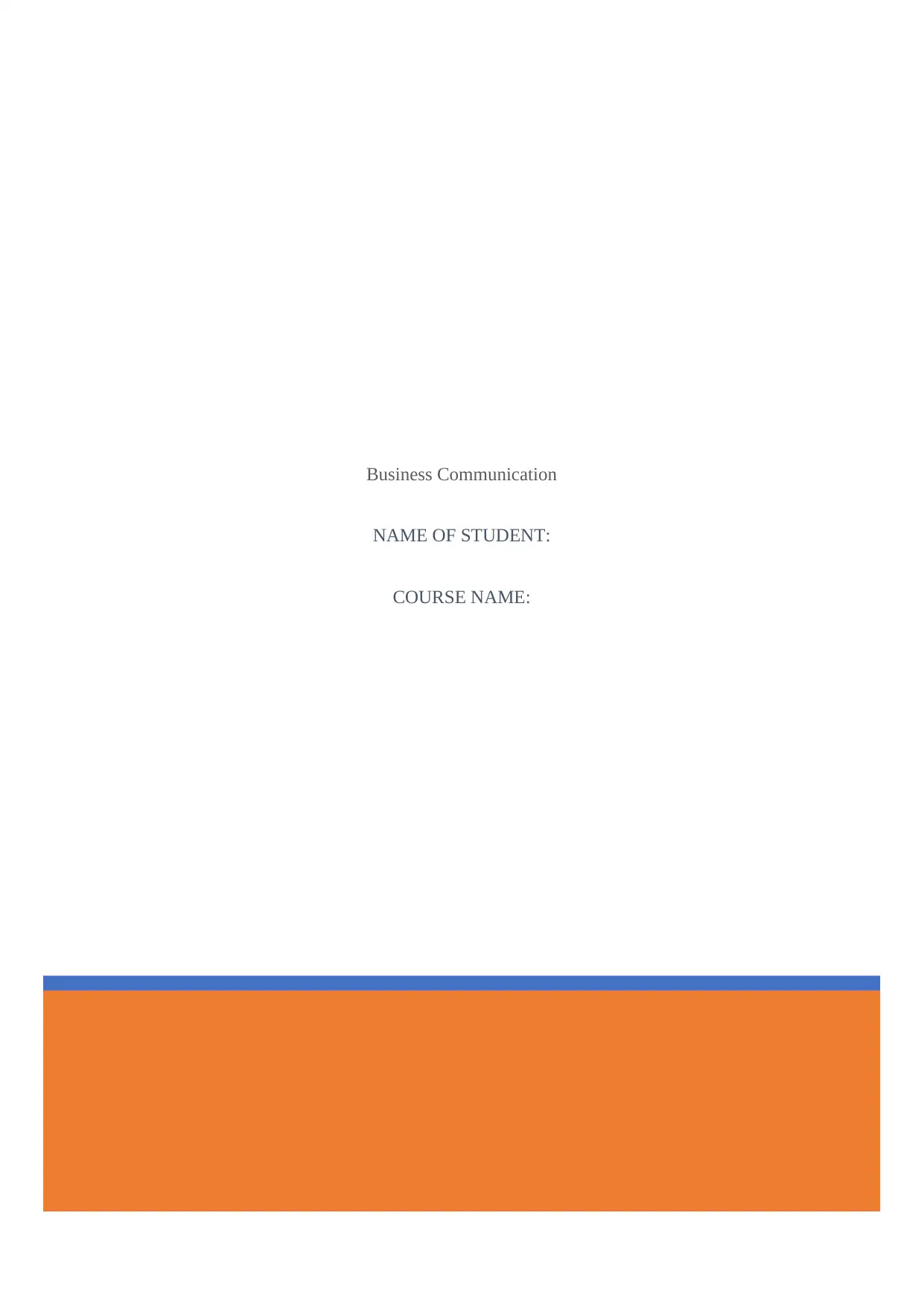
Business Communication
NAME OF STUDENT:
COURSE NAME:
NAME OF STUDENT:
COURSE NAME:
Paraphrase This Document
Need a fresh take? Get an instant paraphrase of this document with our AI Paraphraser
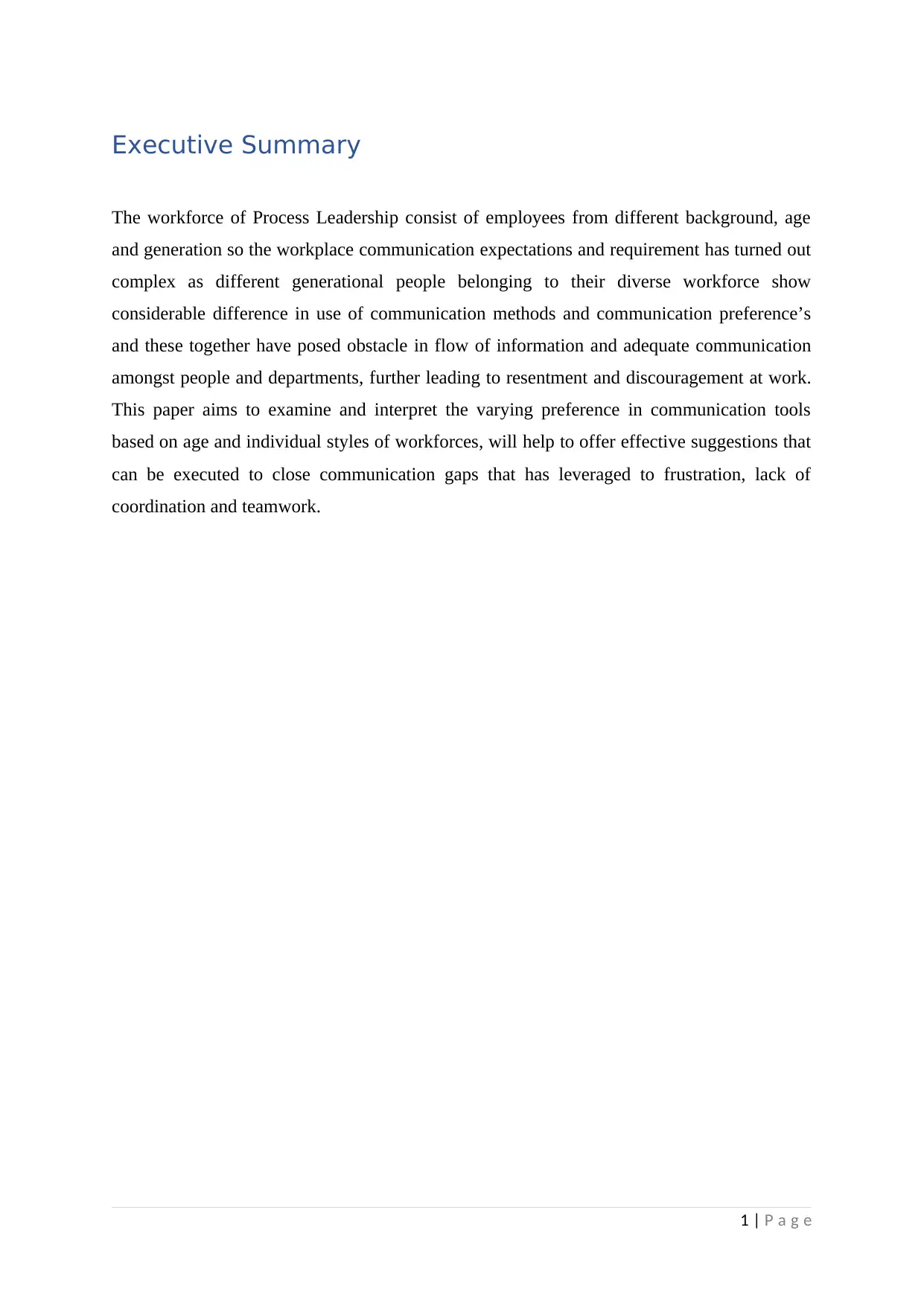
Executive Summary
The workforce of Process Leadership consist of employees from different background, age
and generation so the workplace communication expectations and requirement has turned out
complex as different generational people belonging to their diverse workforce show
considerable difference in use of communication methods and communication preference’s
and these together have posed obstacle in flow of information and adequate communication
amongst people and departments, further leading to resentment and discouragement at work.
This paper aims to examine and interpret the varying preference in communication tools
based on age and individual styles of workforces, will help to offer effective suggestions that
can be executed to close communication gaps that has leveraged to frustration, lack of
coordination and teamwork.
1 | P a g e
The workforce of Process Leadership consist of employees from different background, age
and generation so the workplace communication expectations and requirement has turned out
complex as different generational people belonging to their diverse workforce show
considerable difference in use of communication methods and communication preference’s
and these together have posed obstacle in flow of information and adequate communication
amongst people and departments, further leading to resentment and discouragement at work.
This paper aims to examine and interpret the varying preference in communication tools
based on age and individual styles of workforces, will help to offer effective suggestions that
can be executed to close communication gaps that has leveraged to frustration, lack of
coordination and teamwork.
1 | P a g e
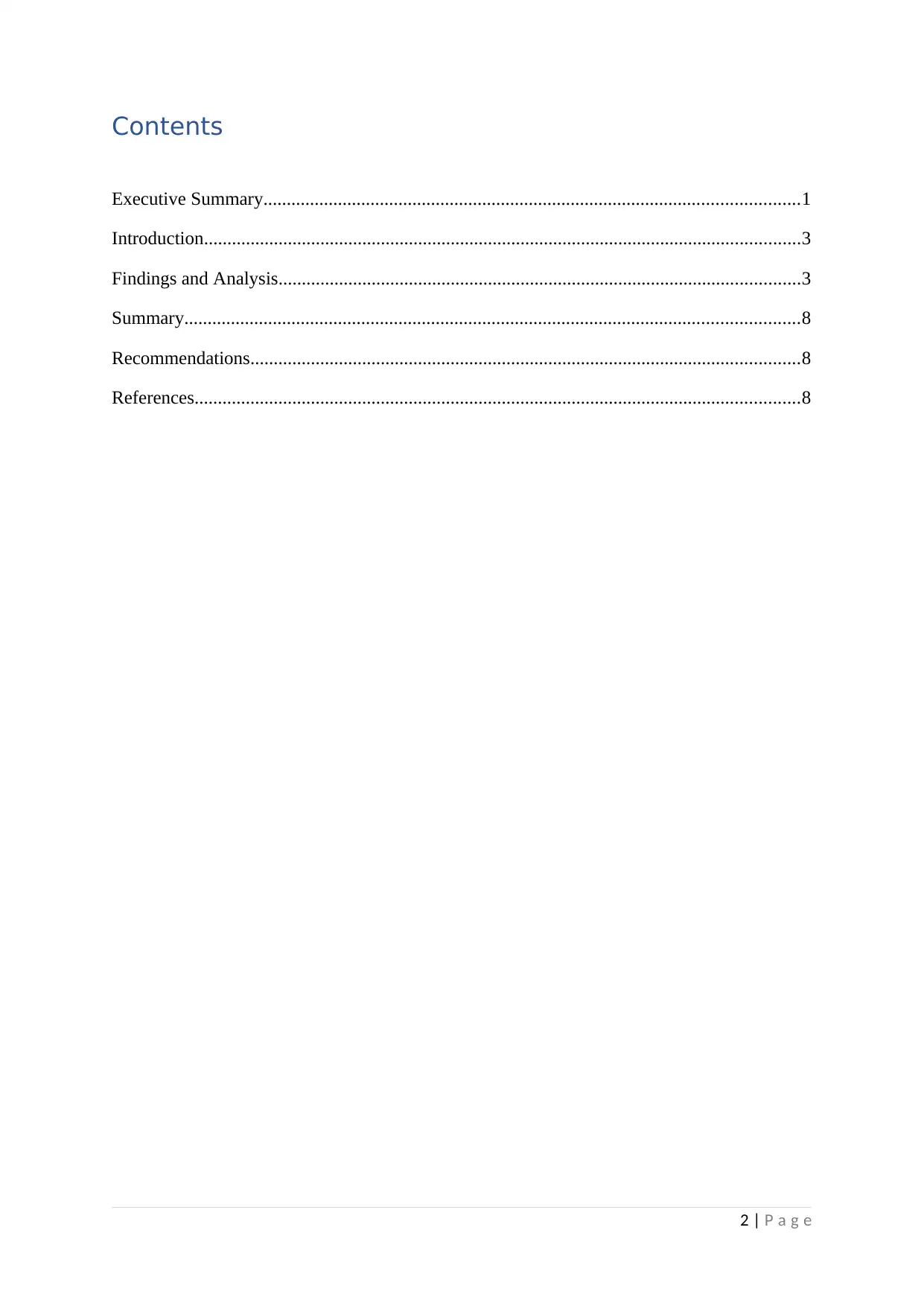
Contents
Executive Summary...................................................................................................................1
Introduction................................................................................................................................3
Findings and Analysis................................................................................................................3
Summary....................................................................................................................................8
Recommendations......................................................................................................................8
References..................................................................................................................................8
2 | P a g e
Executive Summary...................................................................................................................1
Introduction................................................................................................................................3
Findings and Analysis................................................................................................................3
Summary....................................................................................................................................8
Recommendations......................................................................................................................8
References..................................................................................................................................8
2 | P a g e
⊘ This is a preview!⊘
Do you want full access?
Subscribe today to unlock all pages.

Trusted by 1+ million students worldwide
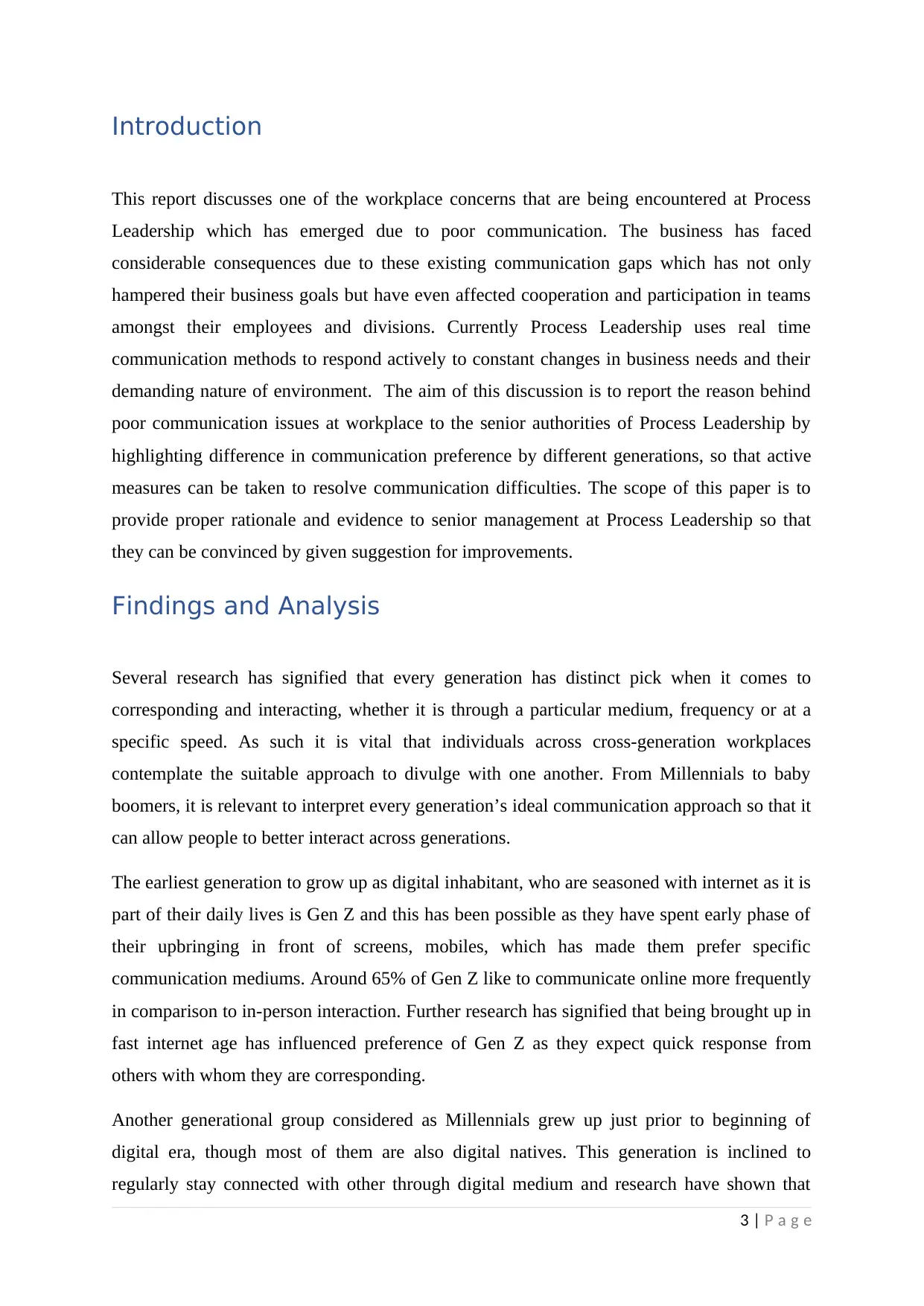
Introduction
This report discusses one of the workplace concerns that are being encountered at Process
Leadership which has emerged due to poor communication. The business has faced
considerable consequences due to these existing communication gaps which has not only
hampered their business goals but have even affected cooperation and participation in teams
amongst their employees and divisions. Currently Process Leadership uses real time
communication methods to respond actively to constant changes in business needs and their
demanding nature of environment. The aim of this discussion is to report the reason behind
poor communication issues at workplace to the senior authorities of Process Leadership by
highlighting difference in communication preference by different generations, so that active
measures can be taken to resolve communication difficulties. The scope of this paper is to
provide proper rationale and evidence to senior management at Process Leadership so that
they can be convinced by given suggestion for improvements.
Findings and Analysis
Several research has signified that every generation has distinct pick when it comes to
corresponding and interacting, whether it is through a particular medium, frequency or at a
specific speed. As such it is vital that individuals across cross-generation workplaces
contemplate the suitable approach to divulge with one another. From Millennials to baby
boomers, it is relevant to interpret every generation’s ideal communication approach so that it
can allow people to better interact across generations.
The earliest generation to grow up as digital inhabitant, who are seasoned with internet as it is
part of their daily lives is Gen Z and this has been possible as they have spent early phase of
their upbringing in front of screens, mobiles, which has made them prefer specific
communication mediums. Around 65% of Gen Z like to communicate online more frequently
in comparison to in-person interaction. Further research has signified that being brought up in
fast internet age has influenced preference of Gen Z as they expect quick response from
others with whom they are corresponding.
Another generational group considered as Millennials grew up just prior to beginning of
digital era, though most of them are also digital natives. This generation is inclined to
regularly stay connected with other through digital medium and research have shown that
3 | P a g e
This report discusses one of the workplace concerns that are being encountered at Process
Leadership which has emerged due to poor communication. The business has faced
considerable consequences due to these existing communication gaps which has not only
hampered their business goals but have even affected cooperation and participation in teams
amongst their employees and divisions. Currently Process Leadership uses real time
communication methods to respond actively to constant changes in business needs and their
demanding nature of environment. The aim of this discussion is to report the reason behind
poor communication issues at workplace to the senior authorities of Process Leadership by
highlighting difference in communication preference by different generations, so that active
measures can be taken to resolve communication difficulties. The scope of this paper is to
provide proper rationale and evidence to senior management at Process Leadership so that
they can be convinced by given suggestion for improvements.
Findings and Analysis
Several research has signified that every generation has distinct pick when it comes to
corresponding and interacting, whether it is through a particular medium, frequency or at a
specific speed. As such it is vital that individuals across cross-generation workplaces
contemplate the suitable approach to divulge with one another. From Millennials to baby
boomers, it is relevant to interpret every generation’s ideal communication approach so that it
can allow people to better interact across generations.
The earliest generation to grow up as digital inhabitant, who are seasoned with internet as it is
part of their daily lives is Gen Z and this has been possible as they have spent early phase of
their upbringing in front of screens, mobiles, which has made them prefer specific
communication mediums. Around 65% of Gen Z like to communicate online more frequently
in comparison to in-person interaction. Further research has signified that being brought up in
fast internet age has influenced preference of Gen Z as they expect quick response from
others with whom they are corresponding.
Another generational group considered as Millennials grew up just prior to beginning of
digital era, though most of them are also digital natives. This generation is inclined to
regularly stay connected with other through digital medium and research have shown that
3 | P a g e
Paraphrase This Document
Need a fresh take? Get an instant paraphrase of this document with our AI Paraphraser
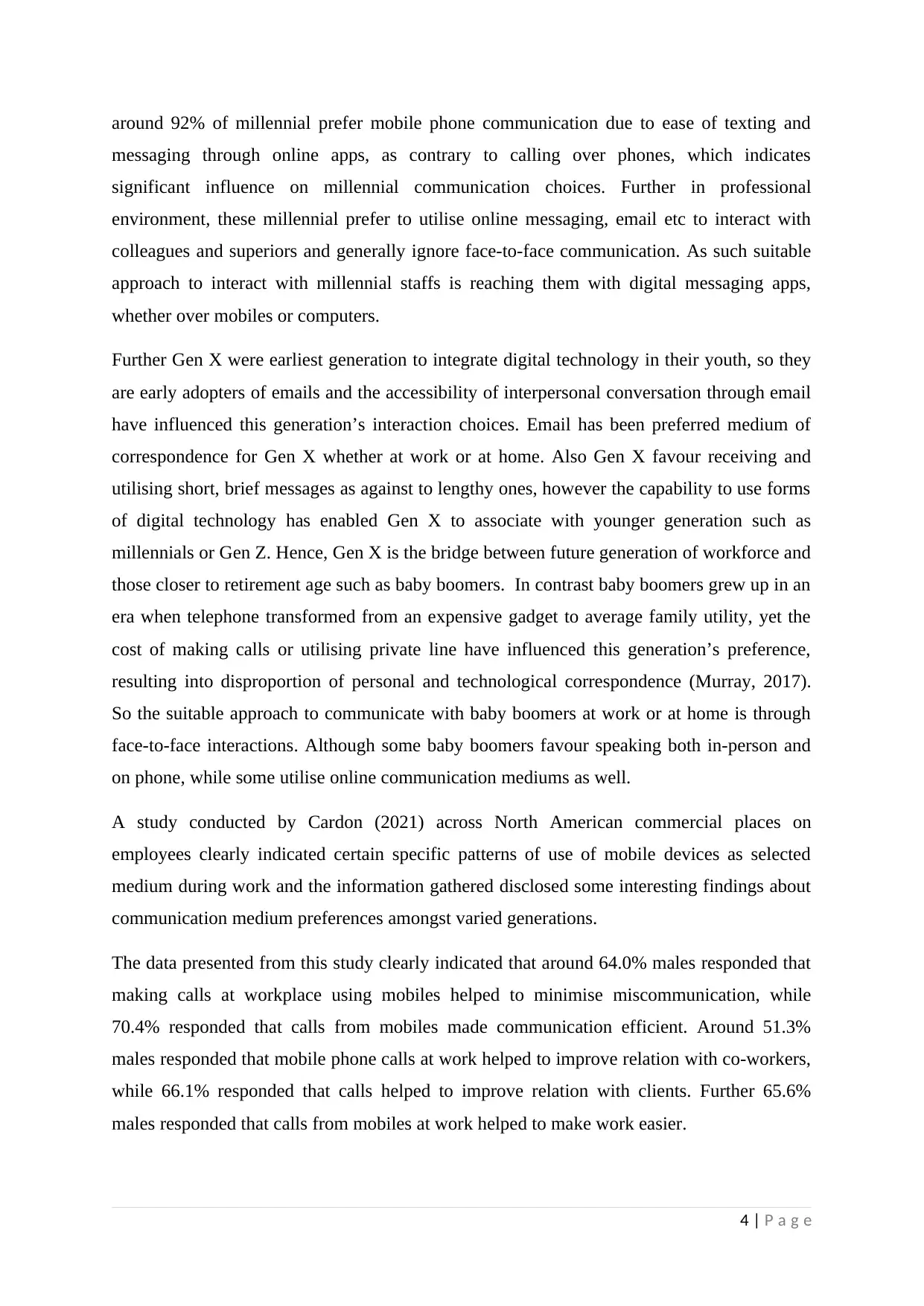
around 92% of millennial prefer mobile phone communication due to ease of texting and
messaging through online apps, as contrary to calling over phones, which indicates
significant influence on millennial communication choices. Further in professional
environment, these millennial prefer to utilise online messaging, email etc to interact with
colleagues and superiors and generally ignore face-to-face communication. As such suitable
approach to interact with millennial staffs is reaching them with digital messaging apps,
whether over mobiles or computers.
Further Gen X were earliest generation to integrate digital technology in their youth, so they
are early adopters of emails and the accessibility of interpersonal conversation through email
have influenced this generation’s interaction choices. Email has been preferred medium of
correspondence for Gen X whether at work or at home. Also Gen X favour receiving and
utilising short, brief messages as against to lengthy ones, however the capability to use forms
of digital technology has enabled Gen X to associate with younger generation such as
millennials or Gen Z. Hence, Gen X is the bridge between future generation of workforce and
those closer to retirement age such as baby boomers. In contrast baby boomers grew up in an
era when telephone transformed from an expensive gadget to average family utility, yet the
cost of making calls or utilising private line have influenced this generation’s preference,
resulting into disproportion of personal and technological correspondence (Murray, 2017).
So the suitable approach to communicate with baby boomers at work or at home is through
face-to-face interactions. Although some baby boomers favour speaking both in-person and
on phone, while some utilise online communication mediums as well.
A study conducted by Cardon (2021) across North American commercial places on
employees clearly indicated certain specific patterns of use of mobile devices as selected
medium during work and the information gathered disclosed some interesting findings about
communication medium preferences amongst varied generations.
The data presented from this study clearly indicated that around 64.0% males responded that
making calls at workplace using mobiles helped to minimise miscommunication, while
70.4% responded that calls from mobiles made communication efficient. Around 51.3%
males responded that mobile phone calls at work helped to improve relation with co-workers,
while 66.1% responded that calls helped to improve relation with clients. Further 65.6%
males responded that calls from mobiles at work helped to make work easier.
4 | P a g e
messaging through online apps, as contrary to calling over phones, which indicates
significant influence on millennial communication choices. Further in professional
environment, these millennial prefer to utilise online messaging, email etc to interact with
colleagues and superiors and generally ignore face-to-face communication. As such suitable
approach to interact with millennial staffs is reaching them with digital messaging apps,
whether over mobiles or computers.
Further Gen X were earliest generation to integrate digital technology in their youth, so they
are early adopters of emails and the accessibility of interpersonal conversation through email
have influenced this generation’s interaction choices. Email has been preferred medium of
correspondence for Gen X whether at work or at home. Also Gen X favour receiving and
utilising short, brief messages as against to lengthy ones, however the capability to use forms
of digital technology has enabled Gen X to associate with younger generation such as
millennials or Gen Z. Hence, Gen X is the bridge between future generation of workforce and
those closer to retirement age such as baby boomers. In contrast baby boomers grew up in an
era when telephone transformed from an expensive gadget to average family utility, yet the
cost of making calls or utilising private line have influenced this generation’s preference,
resulting into disproportion of personal and technological correspondence (Murray, 2017).
So the suitable approach to communicate with baby boomers at work or at home is through
face-to-face interactions. Although some baby boomers favour speaking both in-person and
on phone, while some utilise online communication mediums as well.
A study conducted by Cardon (2021) across North American commercial places on
employees clearly indicated certain specific patterns of use of mobile devices as selected
medium during work and the information gathered disclosed some interesting findings about
communication medium preferences amongst varied generations.
The data presented from this study clearly indicated that around 64.0% males responded that
making calls at workplace using mobiles helped to minimise miscommunication, while
70.4% responded that calls from mobiles made communication efficient. Around 51.3%
males responded that mobile phone calls at work helped to improve relation with co-workers,
while 66.1% responded that calls helped to improve relation with clients. Further 65.6%
males responded that calls from mobiles at work helped to make work easier.
4 | P a g e
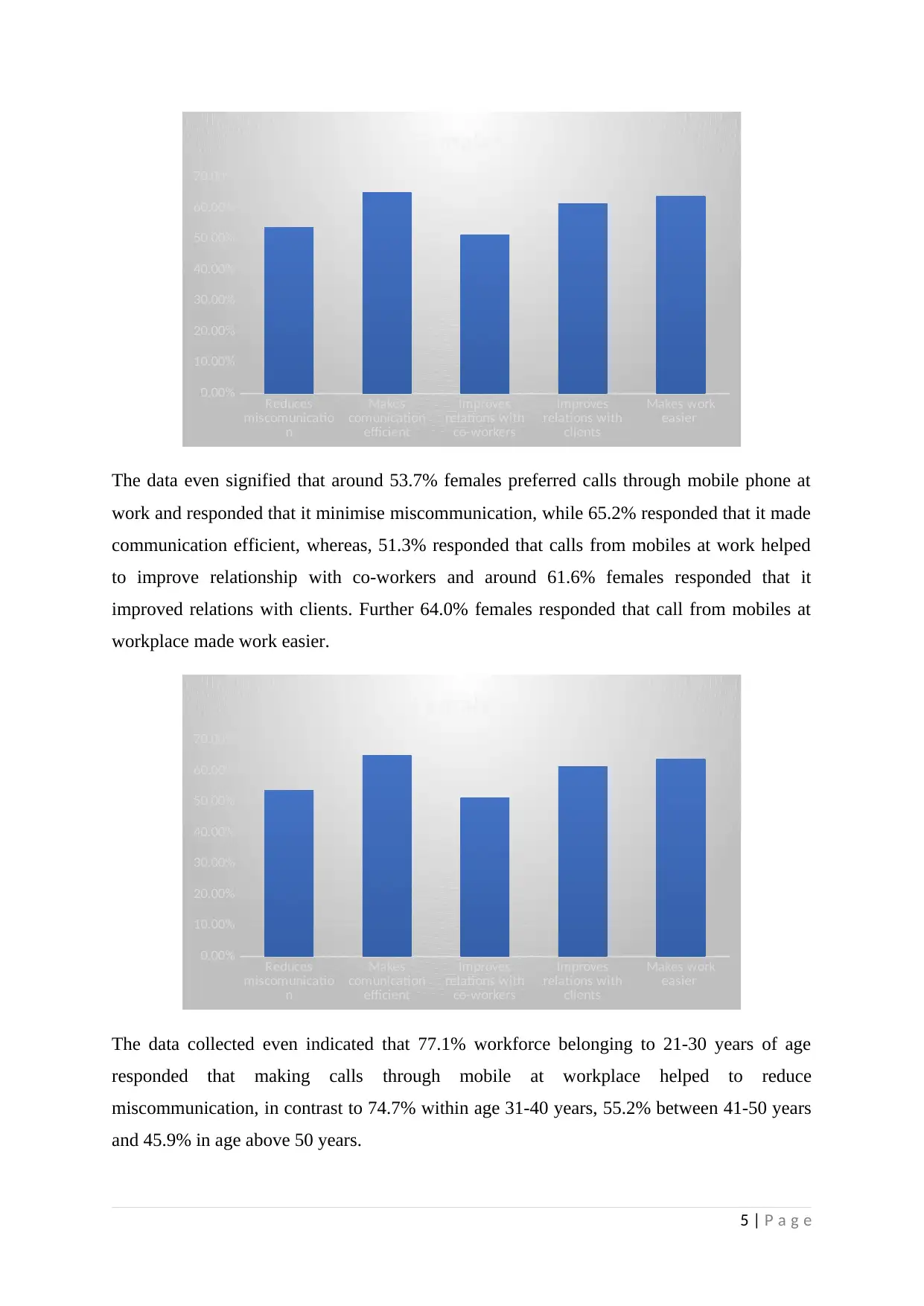
Reduces
miscomunicatio
n
Makes
comunication
efficient
Improves
relations with
co-workers
Improves
relations with
clients
Makes work
easier
0.00%
10.00%
20.00%
30.00%
40.00%
50.00%
60.00%
70.00%
Females
The data even signified that around 53.7% females preferred calls through mobile phone at
work and responded that it minimise miscommunication, while 65.2% responded that it made
communication efficient, whereas, 51.3% responded that calls from mobiles at work helped
to improve relationship with co-workers and around 61.6% females responded that it
improved relations with clients. Further 64.0% females responded that call from mobiles at
workplace made work easier.
Reduces
miscomunicatio
n
Makes
comunication
efficient
Improves
relations with
co-workers
Improves
relations with
clients
Makes work
easier
0.00%
10.00%
20.00%
30.00%
40.00%
50.00%
60.00%
70.00%
Females
The data collected even indicated that 77.1% workforce belonging to 21-30 years of age
responded that making calls through mobile at workplace helped to reduce
miscommunication, in contrast to 74.7% within age 31-40 years, 55.2% between 41-50 years
and 45.9% in age above 50 years.
5 | P a g e
miscomunicatio
n
Makes
comunication
efficient
Improves
relations with
co-workers
Improves
relations with
clients
Makes work
easier
0.00%
10.00%
20.00%
30.00%
40.00%
50.00%
60.00%
70.00%
Females
The data even signified that around 53.7% females preferred calls through mobile phone at
work and responded that it minimise miscommunication, while 65.2% responded that it made
communication efficient, whereas, 51.3% responded that calls from mobiles at work helped
to improve relationship with co-workers and around 61.6% females responded that it
improved relations with clients. Further 64.0% females responded that call from mobiles at
workplace made work easier.
Reduces
miscomunicatio
n
Makes
comunication
efficient
Improves
relations with
co-workers
Improves
relations with
clients
Makes work
easier
0.00%
10.00%
20.00%
30.00%
40.00%
50.00%
60.00%
70.00%
Females
The data collected even indicated that 77.1% workforce belonging to 21-30 years of age
responded that making calls through mobile at workplace helped to reduce
miscommunication, in contrast to 74.7% within age 31-40 years, 55.2% between 41-50 years
and 45.9% in age above 50 years.
5 | P a g e
⊘ This is a preview!⊘
Do you want full access?
Subscribe today to unlock all pages.

Trusted by 1+ million students worldwide
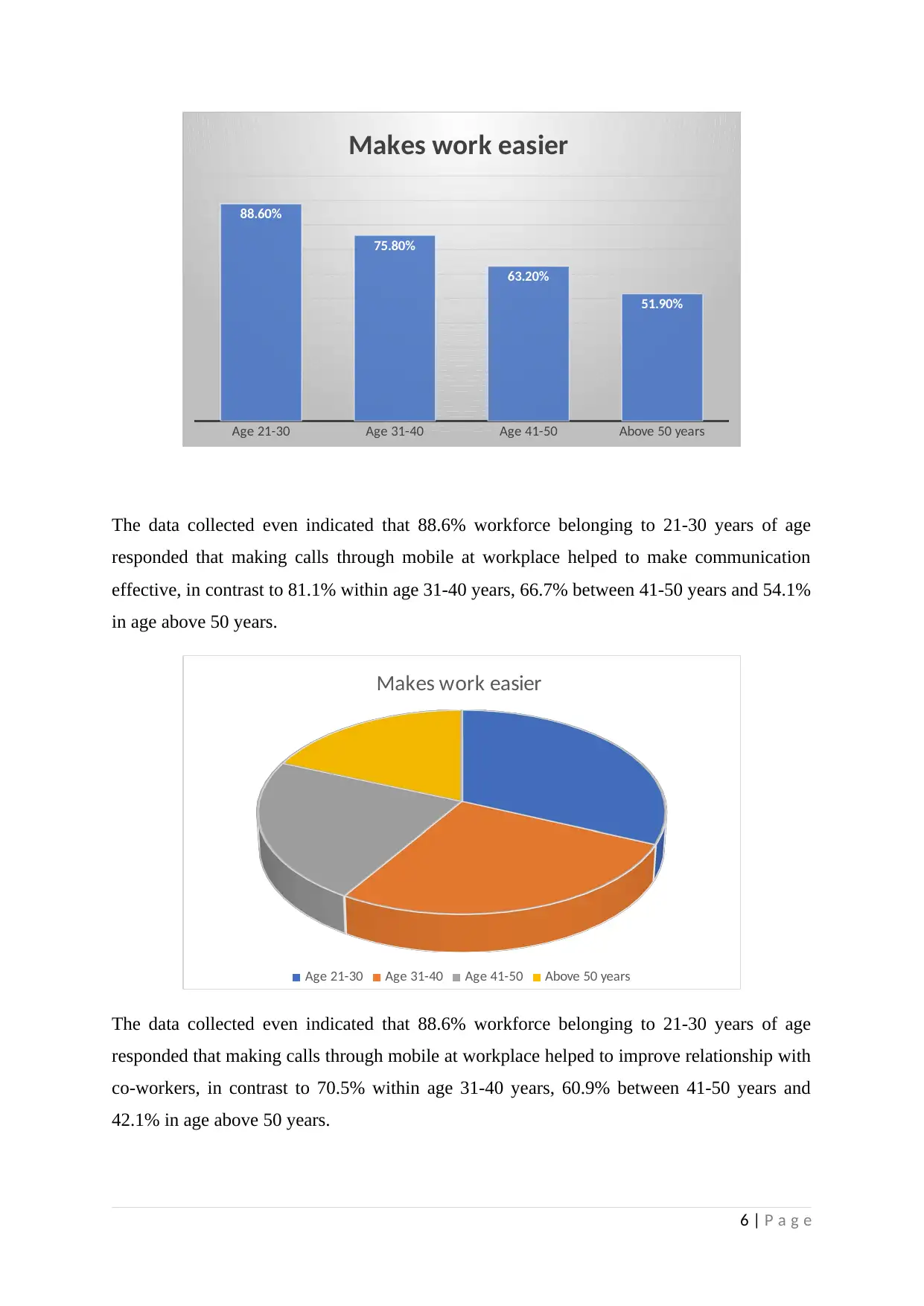
Age 21-30 Age 31-40 Age 41-50 Above 50 years
88.60%
75.80%
63.20%
51.90%
Makes work easier
The data collected even indicated that 88.6% workforce belonging to 21-30 years of age
responded that making calls through mobile at workplace helped to make communication
effective, in contrast to 81.1% within age 31-40 years, 66.7% between 41-50 years and 54.1%
in age above 50 years.
Makes work easier
Age 21-30 Age 31-40 Age 41-50 Above 50 years
The data collected even indicated that 88.6% workforce belonging to 21-30 years of age
responded that making calls through mobile at workplace helped to improve relationship with
co-workers, in contrast to 70.5% within age 31-40 years, 60.9% between 41-50 years and
42.1% in age above 50 years.
6 | P a g e
88.60%
75.80%
63.20%
51.90%
Makes work easier
The data collected even indicated that 88.6% workforce belonging to 21-30 years of age
responded that making calls through mobile at workplace helped to make communication
effective, in contrast to 81.1% within age 31-40 years, 66.7% between 41-50 years and 54.1%
in age above 50 years.
Makes work easier
Age 21-30 Age 31-40 Age 41-50 Above 50 years
The data collected even indicated that 88.6% workforce belonging to 21-30 years of age
responded that making calls through mobile at workplace helped to improve relationship with
co-workers, in contrast to 70.5% within age 31-40 years, 60.9% between 41-50 years and
42.1% in age above 50 years.
6 | P a g e
Paraphrase This Document
Need a fresh take? Get an instant paraphrase of this document with our AI Paraphraser
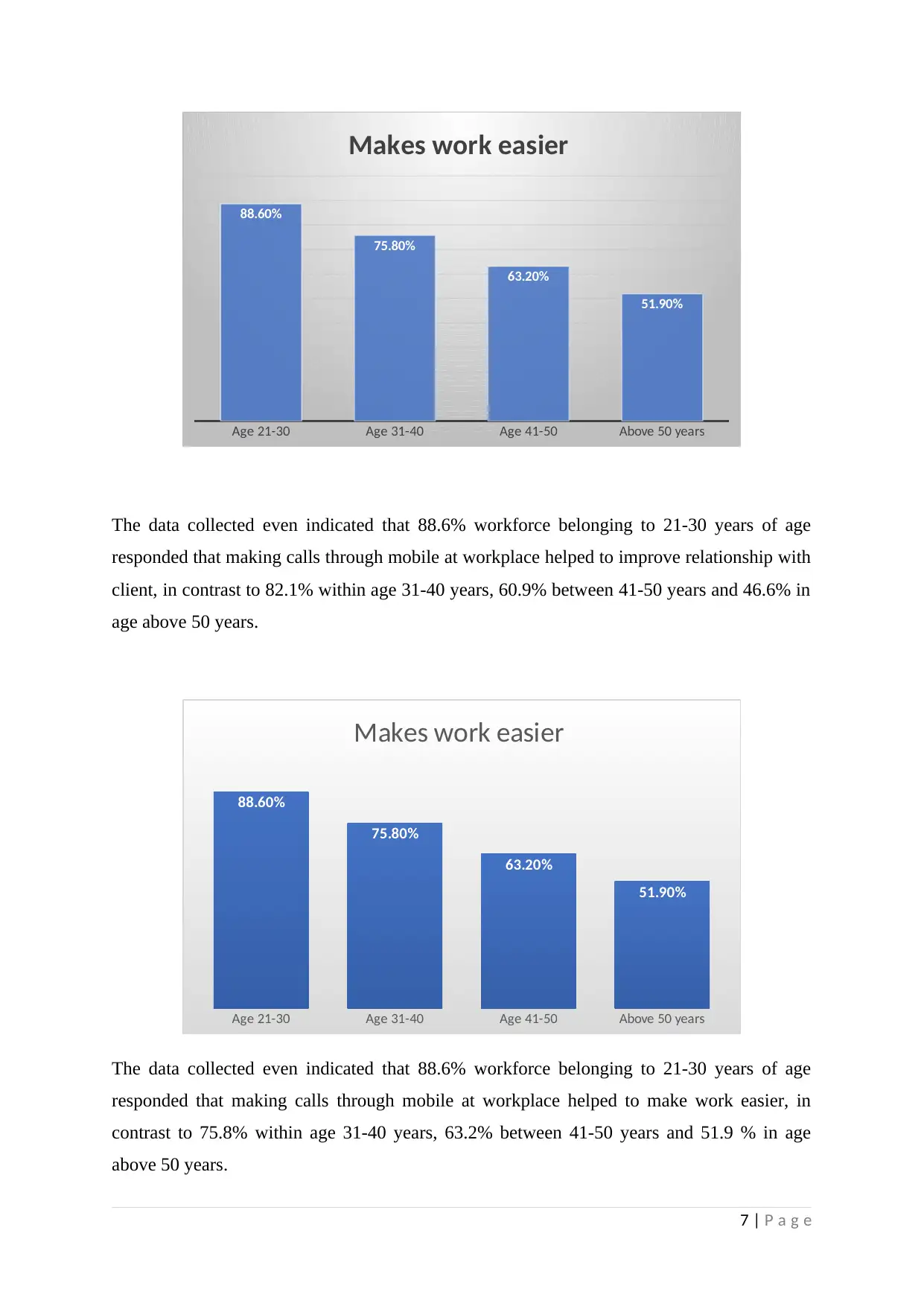
Age 21-30 Age 31-40 Age 41-50 Above 50 years
88.60%
75.80%
63.20%
51.90%
Makes work easier
The data collected even indicated that 88.6% workforce belonging to 21-30 years of age
responded that making calls through mobile at workplace helped to improve relationship with
client, in contrast to 82.1% within age 31-40 years, 60.9% between 41-50 years and 46.6% in
age above 50 years.
Age 21-30 Age 31-40 Age 41-50 Above 50 years
88.60%
75.80%
63.20%
51.90%
Makes work easier
The data collected even indicated that 88.6% workforce belonging to 21-30 years of age
responded that making calls through mobile at workplace helped to make work easier, in
contrast to 75.8% within age 31-40 years, 63.2% between 41-50 years and 51.9 % in age
above 50 years.
7 | P a g e
88.60%
75.80%
63.20%
51.90%
Makes work easier
The data collected even indicated that 88.6% workforce belonging to 21-30 years of age
responded that making calls through mobile at workplace helped to improve relationship with
client, in contrast to 82.1% within age 31-40 years, 60.9% between 41-50 years and 46.6% in
age above 50 years.
Age 21-30 Age 31-40 Age 41-50 Above 50 years
88.60%
75.80%
63.20%
51.90%
Makes work easier
The data collected even indicated that 88.6% workforce belonging to 21-30 years of age
responded that making calls through mobile at workplace helped to make work easier, in
contrast to 75.8% within age 31-40 years, 63.2% between 41-50 years and 51.9 % in age
above 50 years.
7 | P a g e
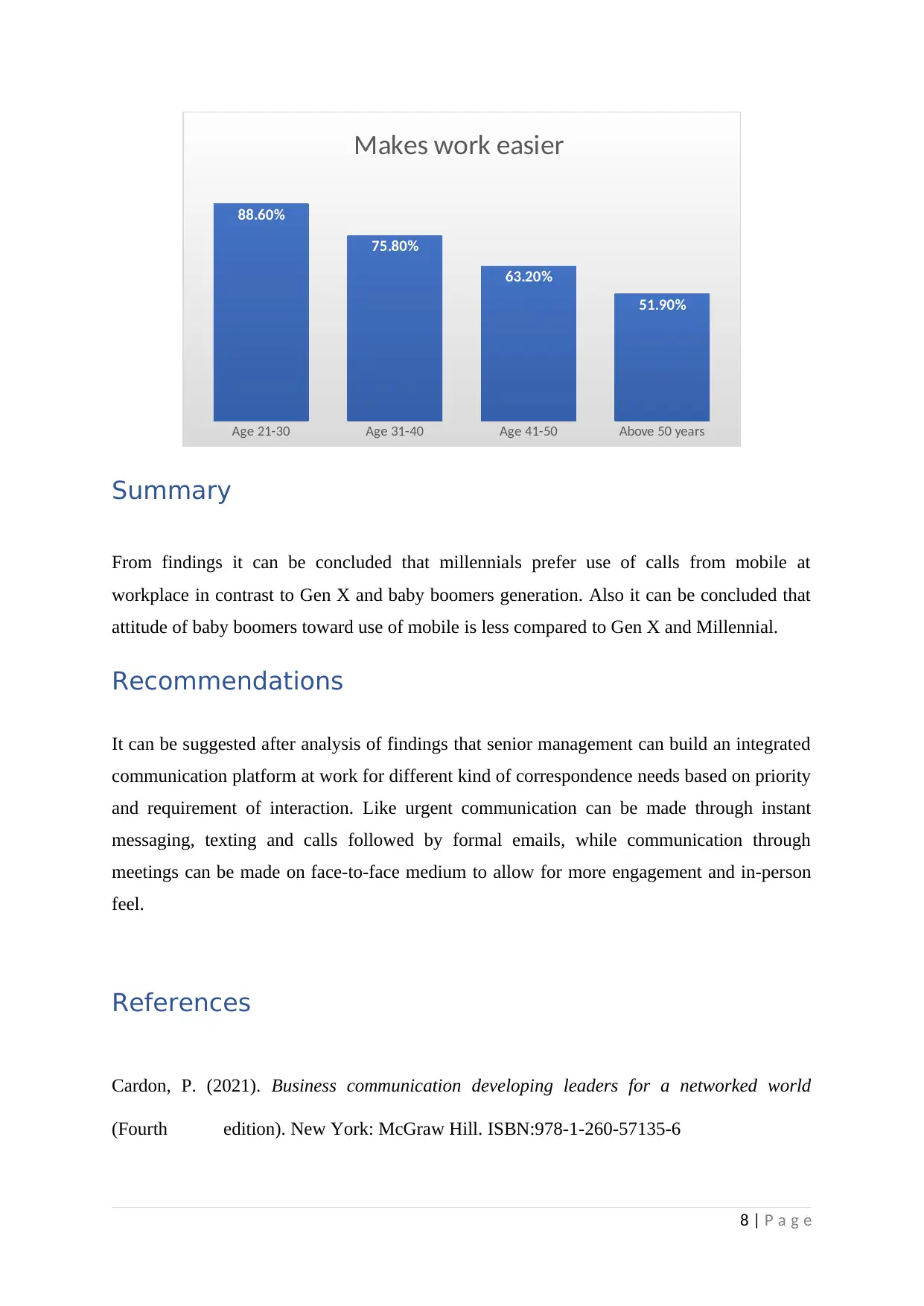
Age 21-30 Age 31-40 Age 41-50 Above 50 years
88.60%
75.80%
63.20%
51.90%
Makes work easier
Summary
From findings it can be concluded that millennials prefer use of calls from mobile at
workplace in contrast to Gen X and baby boomers generation. Also it can be concluded that
attitude of baby boomers toward use of mobile is less compared to Gen X and Millennial.
Recommendations
It can be suggested after analysis of findings that senior management can build an integrated
communication platform at work for different kind of correspondence needs based on priority
and requirement of interaction. Like urgent communication can be made through instant
messaging, texting and calls followed by formal emails, while communication through
meetings can be made on face-to-face medium to allow for more engagement and in-person
feel.
References
Cardon, P. (2021). Business communication developing leaders for a networked world
(Fourth edition). New York: McGraw Hill. ISBN:978-1-260-57135-6
8 | P a g e
88.60%
75.80%
63.20%
51.90%
Makes work easier
Summary
From findings it can be concluded that millennials prefer use of calls from mobile at
workplace in contrast to Gen X and baby boomers generation. Also it can be concluded that
attitude of baby boomers toward use of mobile is less compared to Gen X and Millennial.
Recommendations
It can be suggested after analysis of findings that senior management can build an integrated
communication platform at work for different kind of correspondence needs based on priority
and requirement of interaction. Like urgent communication can be made through instant
messaging, texting and calls followed by formal emails, while communication through
meetings can be made on face-to-face medium to allow for more engagement and in-person
feel.
References
Cardon, P. (2021). Business communication developing leaders for a networked world
(Fourth edition). New York: McGraw Hill. ISBN:978-1-260-57135-6
8 | P a g e
⊘ This is a preview!⊘
Do you want full access?
Subscribe today to unlock all pages.

Trusted by 1+ million students worldwide
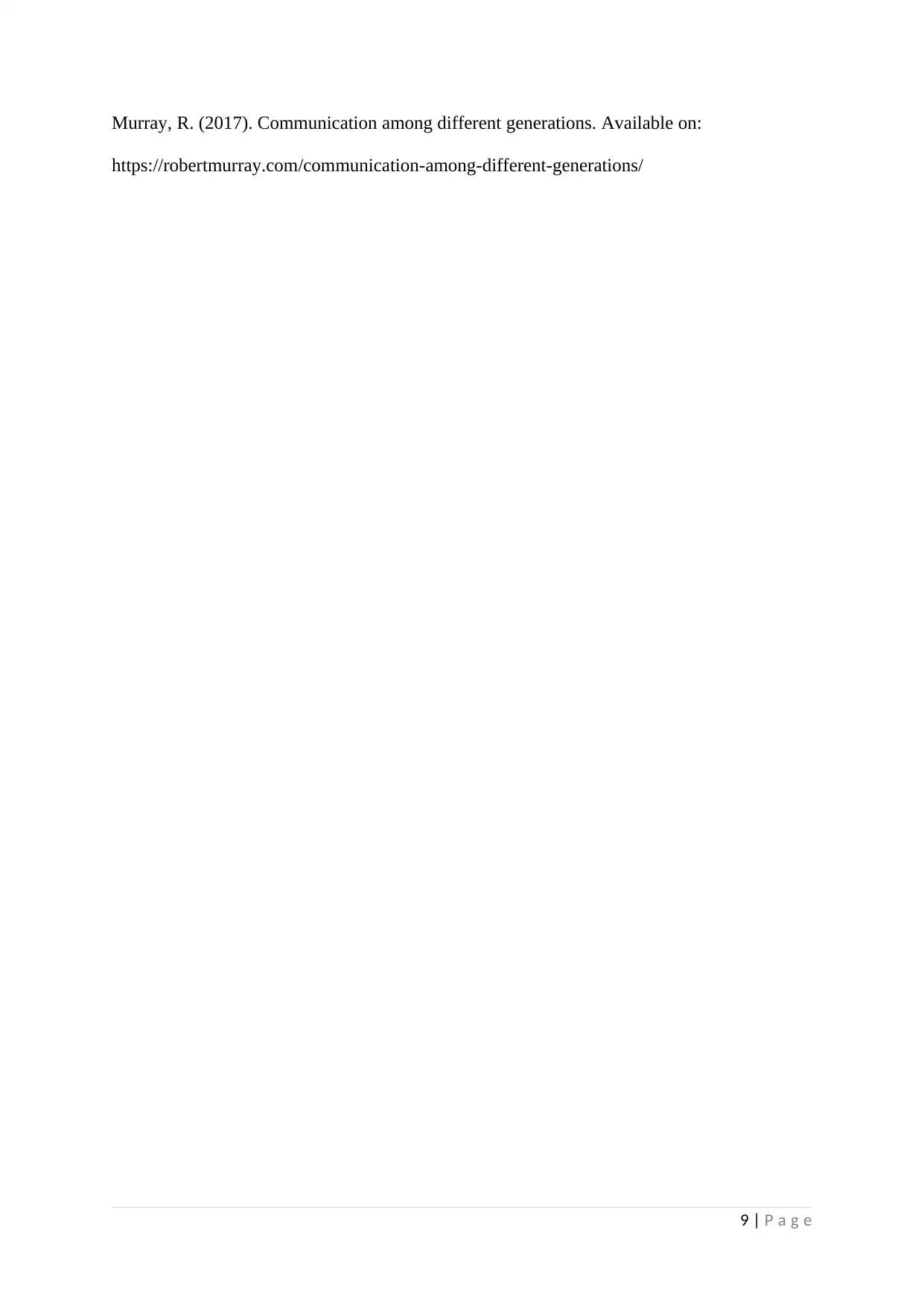
Murray, R. (2017). Communication among different generations. Available on:
https://robertmurray.com/communication-among-different-generations/
9 | P a g e
https://robertmurray.com/communication-among-different-generations/
9 | P a g e
1 out of 10
Related Documents
Your All-in-One AI-Powered Toolkit for Academic Success.
+13062052269
info@desklib.com
Available 24*7 on WhatsApp / Email
![[object Object]](/_next/static/media/star-bottom.7253800d.svg)
Unlock your academic potential
Copyright © 2020–2025 A2Z Services. All Rights Reserved. Developed and managed by ZUCOL.





